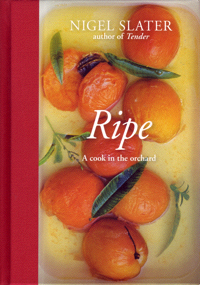Did you follow Super Chef‘s advice and indulge in Nigel Slater‘s Tender: A Cook and His Vegetable Patch?
(See Nigel Slater: Tender.)
If you had, then you’d be enjoying his recipes for summer vegetables and taking pleasure in his sensual writing.
Take another piece of advice; get the companion book, Ripe: A Cook in the Orchard (Ten Speed 2012). The book is a paean to the abundant fruit from his orchard and garden, complete with stunning photographs by Jonathan Lovekin of those hardy British apple varieties with their blossoms or fallen autumn leaves, stunning blushing apricots, and peaches with shades to match a garden rose. This is a book about how to grow and tend fruit with recipes that highlight the fruit’s flavor.
It’s June, so peaches are just starting to arrive in the market from Georgia and points south. What does Nigel think of peaches?
Grown in a tree that is older than its owner, its skin is covered with gray down. And that for me is the point of the peach and why I hold its qualities above those of the nectarine– the feel of the peach’s soft fuzz on first my upper and then my lower lip, the way the skin puckers as I bite, a teasing prelude to the sweet flesh that will follow. And all this before the juice–sweet, cool, sensuous–even touches my tongue. (p. 337)
It might not be wise to read the peach chapter in winter. At the end of introduction to peaches, Nigel writes: ” I like the fact that the pit of the peach contains a little cyanide, though not as much as its sister, the bitter almond. The far-off hint of danger seems only to add to the peach’s exotic and sensual qualities.” (p. 339) He writes about how to grow peaches in different kinds of gardens, describes with personal knowledge the varieties of peaches and nectarines, and what goes best with peaches in the kitchen.
 The recipes for peaches range from A Salad of Peaches, Mozzarella, and Basil (p. 344) dressed with crème fraiche and white tarragon vinegar. There is the lightly rich Crispy Pork Belly, Sweet Peach Salsa (p. 346) with cilantro, chile, and cherry tomatoes. Because lemon can bring out the flavors of a peach so well, Nigel has several recipes focused on lemon flavors, including Peaches with Lemon Verbena (p. 349) that he suggests for an afternoon cup of green tea, and Peaches with Kaffir Lime Leaves and Lemongrass (p. 349), another variation on stewed peaches. The photograph of roses and a peach accompanies Peaches with Rose Petals (p. 355). Again, another stew peach dish flavored with elderflower cordial and served with rose petals. Nigel recommends “one to follow a salmon and cucumber salad on a calm summer day.” What could be more delightful? He finishes off the peaches chapter with Peach and Blueberry Cobbler (p. 357) with a scone crust – this time for late September – but why not tonight?
The recipes for peaches range from A Salad of Peaches, Mozzarella, and Basil (p. 344) dressed with crème fraiche and white tarragon vinegar. There is the lightly rich Crispy Pork Belly, Sweet Peach Salsa (p. 346) with cilantro, chile, and cherry tomatoes. Because lemon can bring out the flavors of a peach so well, Nigel has several recipes focused on lemon flavors, including Peaches with Lemon Verbena (p. 349) that he suggests for an afternoon cup of green tea, and Peaches with Kaffir Lime Leaves and Lemongrass (p. 349), another variation on stewed peaches. The photograph of roses and a peach accompanies Peaches with Rose Petals (p. 355). Again, another stew peach dish flavored with elderflower cordial and served with rose petals. Nigel recommends “one to follow a salmon and cucumber salad on a calm summer day.” What could be more delightful? He finishes off the peaches chapter with Peach and Blueberry Cobbler (p. 357) with a scone crust – this time for late September – but why not tonight?
It’s June, so peaches are just starting to arrive in the market from Georgia and points south. What does Nigel think of peaches?
Grown in a tree that is older than its owner, its skin is covered with gray down. And that for me is the point of the peach and why I hold its qualities above those of the nectarine– the feel of the peach’s soft fuzz on first my upper and then my lower lip, the way the skin puckers as I bite, a teasing prelude to the sweet flesh that will follow. And all this before the juice–sweet, cool, sensuous–even touches my tongue. (p. 337)
It might not be wise to read the peach chapter in winter. At the end of introduction to peaches, Nigel writes: ” I like the fact that the pit of the peach contains a little cyanide, though not as much as its sister, the bitter almond. The far-off hint of danger seems only to add to the peach’s exotic and sensual qualities.” (p. 339) He writes about how to grow peaches in different kinds of gardens, describes with personal knowledge the varieties of peaches and nectarines, and what goes best with peaches in the kitchen.
The recipes for peaches range from A Salad of Peaches, Mozzarella, and Basil (p. 344) dressed with crème fraiche and white tarragon vinegar. There is the lightly rich Crispy Pork Belly, Sweet Peach Salsa (p. 346) with cilantro, chile, and cherry tomatoes. Because lemon can bring out the flavors of a peach so well, Nigel has several recipes focused on lemon flavors, including Peaches with Lemon Verbena (p. 349) that he suggests for an afternoon cup of green tea, and Peaches with Kaffir Lime Leaves and Lemongrass (p. 349), another variation on stewed peaches. The photograph of roses and a peach accompanies Peaches with Rose Petals (p. 355). Again, another stew peach dish flavored with elderflower cordial and served with rose petals. Nigel recommends “one to follow a salmon and cucumber salad on a calm summer day.” What could be more delightful?
He finishes off the peaches chapter with Peach and Blueberry Cobbler (p. 357) with a scone crust – this time for late September – but why not tonight?

